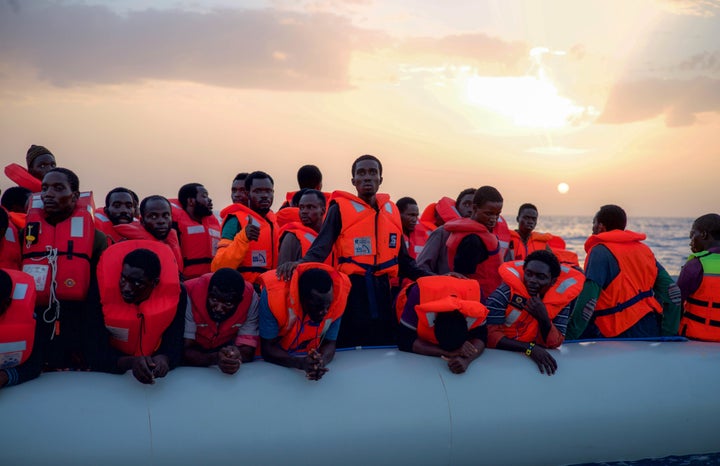
Migrants await rescue after receiving life jackets from the Minden aid ship 18 miles off the Libyan coast.
It’s night, 18 miles off Libya’s coast. I’m waiting alongside Sharo, who is eight months pregnant. That morning, we’d rescued her from a dangerously overcrowded wooden boat. To save her, as well as the children and those who were sick, we’d had to leave her husband. All day, Sharo has battled labor pains and anxiety for her husband. Was he alive? Headed for a refugee processing center hundreds of miles away?
For two weeks, I’ve been a volunteer on the Minden, an 80-foot former German Coast Guard ship operated by two German nongovernmental organizations, Cadus and Lifeboat Project. The Minden now carries a crew of eight – including medical staff and RIB (rigid inflatable boat) operators – to the front lines of the refugee crisis in the Mediterranean.
On my very first shift, at 4 a.m., we passed the Bouri Field, a huge offshore oil and natural gas complex in the East Mediterranean just 65 miles from Libya. Its gas flare is so bright it burned like a candle in my peripheral vision for hours until sunrise. Later, I learned the flare serves as a beacon for migrants heading north to Europe. Smugglers tell them the flare is the faint glow of Italy.
For the first week, we idled next to seven aid vessels from other NGOs – Sea-Eye, Sea-Watch 2, Topaz Responder, Aquarius, Golfo Azzurro, Astral, and the Iuventa – scanning the horizon. But high swells and strong onshore winds kept refugees ashore.
Waiting, we practiced rescue maneuvers and monitored Channel 16 VHF, the open channel for maritime activity. But the channel remained quiet except for late-night requests by Russian trawlers and Egyptian tankers heading to Tripoli, Libya, or European Union warships enforcing the Libyan arms embargo.
On clear days, through binoculars, I could make out a refinery and transmission towers on the coast. There are no landmarks to denote Libya’s territorial waters, so we steered carefully, directed by a series of red pixelated skull-and-crossbones icons on our radar. They look like something from a video game, but we had to take them seriously. In August, the Libyan Navy fired on and boarded the Bourbon Argos, operated by Doctors Without Borders, for crossing the line to help a refugee boat in distress.
After a week, I began to doubt what seemed to be an excessive show of humanitarian assets. Had the migrants moved east, away from us?
Then, as the weather calmed, everything changed.
Over a three-day period, some 11,000 refugees tried to cross the Mediterranean, according to the Italian Coast Guard. These aren’t so much attempts to reach Europe as they are sprints past the Libyan Coast Guard – known to extort money or force rafts to return – to the loose receiving line of rescue boats waiting beyond the 12-mile territorial limit.
The sheer number of rafts overwhelmed our flotilla. Tragedies mounted. Hassim, a Syrian refugee, told me that he and his family had left with seven other boats. Two days later, we’d recovered only three. The others may have drifted out of our patrol area, into the open ocean.
We began to hear of deaths: a pregnant woman, a teenage girl. A man we rescued died hours later from extended exposure to toxic fumes. The next day, I joined the crew of the Astral to load 26 casualties into body bags.
Amid the tragedy – so many risking so much for a chance at a safer, better life – I’m unexpectedly struck by instances of a shared humanity:
Like the group of women from Ivory Coast befriend Cadisha, a mother from Mali who is partially paralyzed from a bullet lodged in her head. The women take turns caring for Dani, her 3-year-old daughter.
Or the realization that on every raft, there will always be two or three people whose glances are so transparent that they emerge as leaders, helping to transform a traumatic situation into a bearable one. They maintain calm on the craft, identify the sick and dead, the pregnant and the children, and ensure that everyone has a life jacket.
Or when a migrant breaks protocol, stepping uninvited onto our RIB – a cardinal rule meant to keep people from panicking – only to lay three broken men near death onto our bow, one by one, and then fall back.
Or when, hours after the rest of our refugees have disembarked safely, Sharo remains aboard and still alone. Then she calls me over and gestures to an oncoming RIB from another aid ship. She whispers: “That’s him. My husband.”
Note: many thanks to the German NGOs, Cadus and the Lifeboat Project, who are working on the frontline of the refugee and migrant crisis. Special thanks to the crew of the Minden.